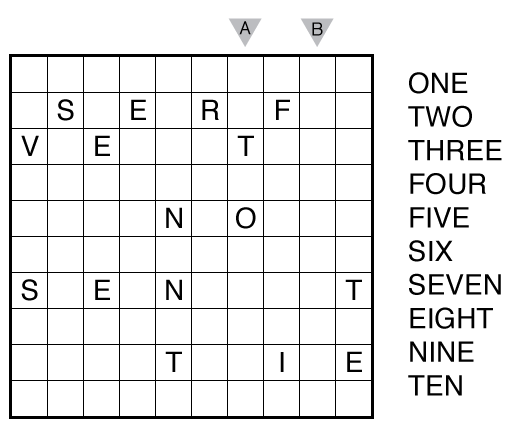The Puzzle Robot #3 – Islands of Numbers

or solve online (using our beta test of Penpa-Edit tools; use Tab to alternate between letter entry and shading)
Theme: Hidden words (each row of letters forms an English word like SERF.)
Rules: Put each number (given as a word) into the grid, one letter per cell, as a snakelike strip which does not touch or cross itself. Some letters of the words are given. The remaining cells should be painted black to form a continuous wall as in a Nurikabe puzzle with no 2×2 shaded regions. Or see here.
Answer String: Enter the contents of each marked column from top to bottom, using X (capital letter) for each blackened square and capital letters for each island cell, and separating the columns with a comma.
Time Standards (highlight to view): Grandmaster = 2:30, Master = 3:30, Expert = 7:00
Solution: PDF

I enjoyed this one — a nice mix of word packing and nurikabe logic. This example was a pretty gentle introduction, but it seems like you could do some pretty deep/tricky puzzles on this theme.
On the input. Wouldn’t a symbol such as a dash or slash be better? There is actually an X in SIX, after all.
I don’t see it as a big deal either way. I guess if I had to put a reason to this subconscious choice, it seems I’m a person who is less concerned with a potential slight loss of information in an already lossy format (20% of a puzzle), than with a potential increase in the time I would take to type the entry.
In other words, if I’m holding down shift and typing letters, I’d rather continue to type letters than have to get a dash (not underscore) or a slash. Of course this means for efficiency I should kill my commas but I never sorted that out. I’d love to have the functionality for confirming alternate strings (such as caps, no caps) but I don’t have that yet.
On places where I need to put down a big bunch of caps letters and other symbols/numbers, I just use the caps lock. I guess it’s a fair point that the string input is already a lossy format, so it doesn’t really matter. It’s just that I remembered on the recent IPC, they changed the input of the blanks from X to / because of the X pentamino.
Just starting to look at this but I have a rules question.
Am I to assume the islands work like in a Nurikabe as well, or should I be expecting that I could cross different word-snakes at a common letter (ones that wouldn’t violate the “can’t touch itself” rule, but would touch each other)?
Thanks!
Each number should be an island entire of itself, without crossing or touching (except diagonally) another island. What primarily differs here from Nurikabe is that (1) islands must be Snake shaped so that a word is cleanly read from start to finish, (2) islands can contain more than one given letter, provided they would be in the right position for the entire word filling the island.
Thank you, Thomas. That was my assumption going in, I just wanted to be sure.
As an aside, I want to thank the Puzzle Robot for an extremely interesting set of puzzles this week. Even his simple twist on a Tapa looks so very lovely on the screen and was genuinely fun to work out.
The rules don’t mention anything about how the different words interact with each other, can we update them so that people don’t need to read through the comments to learn if words are allowed to touch?
I felt tempted to use uniqueness here, say a given E cannot belong to TEN because the positions of T and N would be interchangeable.
In this puzzle type, uniqueness is very useful. Because the designer must give at least one letter in each word. If it is not, there will be more than one solution. Also if the designer wants to give only one letter for all given words, he should avoid to give a middle letter of each word.
If we consider this puzzle, V might be a part of FIVE or SEVEN. As you see V is the middle letter of SEVEN. If V belongs to SEVEN, at least one of given letters must be included with SEVEN. So you are right about uniqueness.